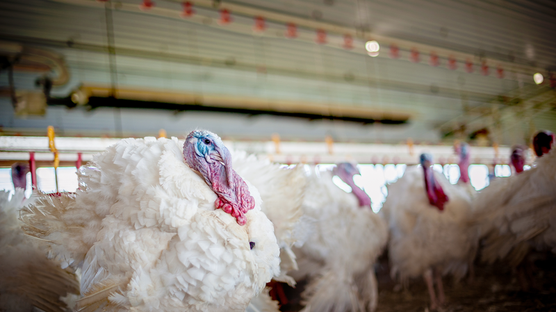
Published on April 23, 2018
Thinking of switching to LED lights? Read this first
Throughout the world, many turkey producers are switching to LED lights in their barns. Significant savings on electrical operating costs makes LED lighting an attractive option. Before you flip the switch, it is important to buy the correct type and to ensure your existing system is properly set up to support LED lighting. Without proper research and set up, poor lighting can result and your birds may be negatively affected.
Note: A glossary of technical terms is available at the end of the article.
It is important to understand that turkeys receive and interpret light differently than humans. Although the lights may seem perfectly normal to our eyes, to a turkey, the light could look like what you see in the video below. I took this video on my cell phone and then played it in slow motion. This is a quick and easy method to check the effect of your LED lights on your turkeys. As you can see, these lights are not set up correctly, leading to a high flicker rate. This situation can increase aggressive behaviour in your flock.
Recommendations for commercial turkey growers
Make sure that whatever light bulbs you buy, fit within these parameters:
- Rated life span: 40 000 to 80 000 hours
- Warranty: 5 full years
- Dimmable: Range of 0.2% through 100%.
- LED beam angle: This is important to consider in order to make sure there are no gaps without light. Uniform spacing and installation of lights, based on the beam angle, will help to avoid dark spaces or shadows on the floor

- Operating temperature: -40F to 131F (-40C to 55C)
- Power factor: Ratio of real power to the apparent (used) power (>0.90%).
- IP grade: 65 or higher. This means that the light is dust tight with no ingress of dust and is protected against water jets from any angle. Note: If the IP grade is too low, especially the second number, the lights could be damaged during washing and disinfection of the barn.
- Color temperature: 4 000 Kelvins (K)

- Foot Candles (FC) or LUX:
First week: 8 to 10 FC = 86.08 LUX to 107 LUX
Second week onwards: 4 to 5 FC = 43.04 LUX to 53.8 LUX
Second week onwards (if the flock has not received beak treatment): 2 to 2.5 FC = 21.52 LUX to 26.9 LUX
Summary
The key to success with lighting is UNIFORMITY.
If you have any questions or concerns about LED lights in your facilities, contact a Hybrid representative or consult with a licensed electrician.
Whether using LED, fluorescent or incandescent lights, it is important to follow a lighting schedule that allows for periods of both light and darkness. For more information on lighting schedules for commercial turkeys visit www.resources.hybridturkeys.com
Glossary
LED: Light Emitting Diode. LED bulbs use a semiconductor device that emits visible light when an electric current passes through it.
IP grade: Ingress Protection grade. This is a measurement of the level of protection of an item against solid objects, such as dust and dirt, and liquids. It is always a two digit number. The first number is a score for protection against solids and is based on a scale of 0-6. The second is the level of protection against liquids and moisture and is scored on a scale of 0-8.
Kelvins: unit of measurement used to describe the hue of a light source
Foot Candle: unit of imperial measurement used to describe the intensity of a light.
LUX: unit of metric measurement used to describe the intensity of a light.



